Rogena Schuyler Silverman Interviews Amy Stahl, MS, PT, CKTI
A PT discusses an increasingly popular rehab modality.
Rehab Management (RM) recently had the opportunity to discuss the use of therapeutic taping in the practice of physical medicine and rehabilitation with Amy Stahl, MS, PT, CKTI.* Stahl and her husband own and operate the C.O.R.E., Center for Orthopedic Rehabilitation & Exercise, Fort Collins, Colo.
RM What is the history of therapeutic taping?
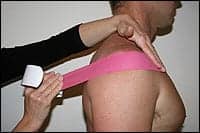 |
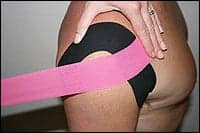 |
| Clinicians use therapeutic taping to help minimize inflammation accumulation, support muscle/ligament/tendon tissues and biomechanics of a joint. |
Stahl Therapeutic taping was developed by Japanese chiropractor Kenzo Kase, DC, in 1973, in an effort to minimize inflammation to improve the outcomes of his clients’ treatments. He developed an elastic therapeutic tape that could be worn for several days and would lift the skin to facilitate the superficial lymphatic pathways, improve circulation, and support muscles and joints while promoting healing. Kase brought his therapeutic taping method to the United States in the mid 1990s (a business that is now run by his daughter, Tomoko Kase). The tape, which is distributed worldwide, is marketed primarily to health care practitioners and is widely used in the clinical rehabilitation and chiropractic settings; it is becoming more popular in professional and athletic training rooms. It is also being implemented in the academic setting, primarily in health care education venues, such as physical therapy, occupational therapy, chiropractic school, athletic training programs, and massage therapy programs.
RM How long have you been using therapeutic taping in your practice?
Stahl I became a certified taping practitioner in January 1999 and a certified taping instructor in June 1999, and have actively been using taping in my practice as a physical therapist and teaching taping to health care practitioners ever since.
RM For what conditions and injuries is therapeutic taping best applied?
Stahl Therapeutic taping is good for a multitude of orthopedic, neurological, and lymphatic types of injuries and conditions. The unique qualities of water-resistant therapeutic tape allow a practitioner to be creative and create a framework for a plan of care to progress a patient from the start of recovery of an injury to the end stages of function. Taping is very versatile and applicable for all stages of healing, and the goal of the taping application is to promote homeostasis of the body to function normally. An example: stage one: lymphatic taping application to promote lymphatic flow and circulation to address pain and inflammation in order to promote healing and start ROM, then tape to stabilize injured joint/tissues as the pain and inflammation decrease to start general stabilization/strengthening exercises, then tape to provide feedback into tissues/joints as patient returns to sport activity/normal function. Each stage of recovery can use a different therapeutic taping application to achieve a desired goal. Each application has a specific result to achieve a specific goal. It is necessary to be appropriately trained in specific application methods to be successful in achieving the treatment goal.
RM Can it be used to prevent injuries?
 |
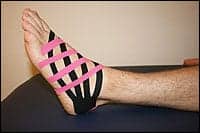 |
Stahl Therapeutic taping can be used to prevent injury to a degree. It will not fully protect a joint from injury or replace a stabilization brace, but it is very good at minimizing inflammation accumulation and supporting muscle/ligament/tendon tissues and biomechanics of a joint and promoting circulation without limiting ROM. It is often utilized for return to sport activity and to minimize the effects of overuse and decrease soreness from activity as a “pro-active” approach for recovery.
RM Why has therapeutic taping become so popular in the mainstream in recent years?
Stahl Therapeutic taping is a very popular choice for pain management because it is a safe and effective modality that is easy to apply, noninvasive, and comfortable to wear and can provide continued treatment for periods of time, 3 to 5 days. It is very complementary to be used with other treatments, such as ultrasound, electrical stimulation, joint mobilization/joint mechanics, myofascial release, ice/heat, and intramuscular stimulation/trigger point dry needling. Once the appropriate application has been determined by a certified taping practitioner, the applications can be taught to the patient to be “pro-active” in independent pain management, thus allowing the patient to be more independent and efficient in controlling their pain and recovery.
RM How long is it safe to remain active with an injury while “taped”?
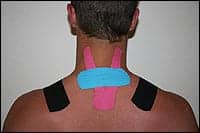 |
 |
 |
|
| Each application has a defined method to create the desired outcome. | Therapeutic taping aids in pain management. It is comfortable to wear and can provide continued treatment for several days. |
Stahl Therapy tape that is designed to be worn for several days (3 to 5 days on average) enables the skin to breathe, dries quickly, is latex free, and can be tolerated for longer periods of time. The application wear time and therapeutic benefit will be determined by the specific application goal, tolerance of the skin, ROM, activity, sweat volume, preservation of the tape with clothes, and so forth. It will still be necessary to protect the injured tissue and allow for normal healing time regarding the physiology even if the patient feels better. Taping will not replace normal recovery of tissue, but can certainly assist in promoting healing by decreasing accumulated edema/inflammation, improve circulation to increase nutrition delivery to traumatized tissue, provide support to injured tissue as it heals, decrease pain, and provide more balance around a joint to improve muscle function and biomechanics.
RM Why is taping so effective? What properties contribute to the tape’s effectiveness?
Stahl [I recommend an] elastic therapeutic tape that is 100% cotton, with 100% medical grade heat-sensitive acrylic glue. The effectiveness of the taping applications is determined by the correct method for which it is applied to achieve the desired outcome. This elastic therapeutic tape is effective when compared to other types of taping, because it can provide joint and muscle support and improve lymphatic flow without limiting ROM and circulation. It is also considered hypoallergenic and can generally be tolerated by the pediatric and geriatric populations, in addition to most of the general population. As far as pain management, the general concept is that by lifting the skin to open the superficial lymphatic pathways, you can promote lymphatic flow and circulation, which in turn can decrease pressure on the pain fibers and create a “vacuum pump” to minimize fluid accumulation.
RM What are the different taping techniques? Which do you prefer to use in your practice? For what conditions?
Stahl There are several taping methods developed by Kase that are specific for different outcomes, depending on assessment and goal of treatment. You can tape for the skin (analgesic) system to decrease pain, enhance the lymphatic/circulatory system, support fascia, stimulate or relax muscle, stabilize joints for healing, and improve biomechanics. Each application has a defined method to create desired outcome, and it is imperative that the application be done correctly to get the most positive results, otherwise adverse reactions can occur and treatment will not be successful. My choice for application is totally dependent on subjective history, physical assessment, and my goal for treatment. If symptoms or injury is acute, I will tape initially for decreasing pain and inflammation and then, as these symptoms decrease, progress to stabilization and support as the tissues heal and therapeutic exercise and ROM and flexibility are introduced, then proceed with muscle enhancement or “biofeedback” or ligament/tendon support as resistive exercises are progressed and the patient returns to sport activity or to normal function. Methods can be combined in one treatment to enhance response and promote healing. Correct understanding of taping methods will make treatment outcomes much more successful. In my clinical setting, in an outpatient orthopedic clinic, I use all method applications fairly regularly. The most frequently used are the “space creator” for localized anti-inflammatory treatment, joint stabilization, and muscle applications.
RM Can harm occur to a client who is incorrectly taped?
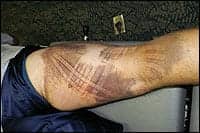 |
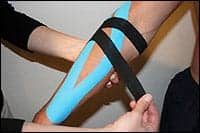 |
| Athletes often find taping provides support, while maintaining ROM and allowing for circulation. |
Stahl If the tape is applied incorrectly, such as applying the tape with too much tension or in the wrong direction, an adverse effect can occur. The most common reaction to an incorrect application is skin irritation, but pain can increase if the wrong tissue/structure is taped, if the muscle application was done incorrectly for the condition; too much compression on the skin can hinder circulation and lymphatic flow—they can all make the taping application unsuccessful. That is why it is very important that clinicians do an appropriate assessment of the injury and are correctly trained in order to choose the most appropriate applications to be successful with the treatment.
RM Who is not a good candidate for therapeutic taping?
Stahl Anyone with fragile skin or a serious medical condition that can be affected by increased lymphatic flow for volumes of fluid, like diabetes, congestive heart failure, infection, coronary artery disease, or deep vein thrombosis. Caution should be used for very young pediatric patients and very elderly patients with thin skin, but can often be appropriately and effectively taped by using a skin barrier to protect the skin. On occasion, an athlete may be required to rest and/or be braced to allow an appropriate healing time for a serious injury, because often once the inflammation and pain have decreased and the tissues are supported, they may try to participate in their chosen activity before they should, just because they feel so much better.
RM Do you see any future trends in therapeutic taping?
Stahl I see it becoming more and more popular, not only in the health care setting, but in schools, athletic clubs, and surgery centers. It is a noninvasive and effective treatment that, when applied correctly, can be very beneficial. It has been widely visible in the Olympic Games since 1988, and is recognizable on many international and professional athletes. It has been a therapeutic choice for many athletes because it provides support while still maintaining ROM and allowing for circulation. It is comfortable and offers a therapeutic benefit for several days. I believe [appropriate research and technician training are] going to be essential for insurance reimbursement depending on the direction our health care goes. Therapeutic taping is now starting to infiltrate the equine and veterinary world and has been used on race horses at the Kentucky Derby and on flamingoes in zoos. It will probably be more widely used on animals [in the future].
Therapeutic taping has been an incredible complementary adjunct to my practice as an outpatient physical therapist. While there is still a huge need for continued research, therapeutic taping is still an ideal choice in pain management, improved circulation, and joint support in my clinic, and it is used daily by the five physical therapists in the office. Patients request therapeutic taping to be part of their regular treatment. Once an appropriate method technique is determined, I frequently teach the patients how to do it for themselves, which can give them more control over their pain and injury when they are not in therapy.
*Amy Stahl, MS, PT, CKTI, and her husband own and operate the C.O.R.E., Center for Orthopedic Rehabilitation & Exercise, in Fort Collins, Colo, an outpatient physical therapy clinic. She is a Certified Kinesio® Taping Practitioner and Certified Kinesio Taping Instructor, and has been actively teaching therapeutic taping to health care practitioners since her certification. Stahl is on the Kinesio Taping Association Educational Committee, and helped write the Standardized Kinesio Taping Curriculum that is taught worldwide. For more information, go to www.coreptfc.com.





